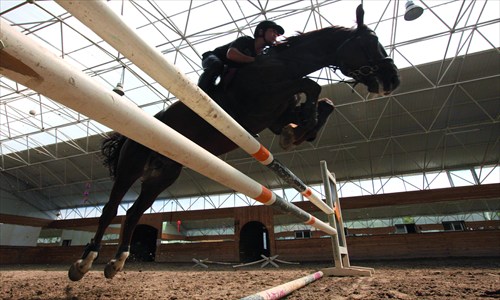
Horse riding is a privilege the world over. Nevertheless the sport, said to have originated in Asia and since perfected by the British monarchy, has seen a surge in popularity and participants since the beginning of the last decade in China. The allure of the sport, which is usually depicted in pictures or on TV screens with robust horses galloping on wild grasslands, partly lies in it being very outdoors-based.
So what do people do when the weather is biting cold? What about when the city is swamped in a sand storm? Indoor riding arenas are definitely an alternative for devoted riders to spend quality time with their beloved equines, and increase the possibility of transferring the sport into a daily event. But are they popular?
"Indoor horse arenas are a great addition to a ranch, providing a safe and controlled riding environment, which can be used all year round," said Yuan Maodong, a riding instructor and manager at the Long Fa Ranch Equestrianism Club, which is located in Daxing district near the South Fifth Ring Road. "Although indoor riding arenas are not a major facility of any ranch, they are a necessary one," Yuan said. "Indoor arenas are used quite often, usually as an alternative for rainy, windy, boiling hot or snowy days. Over last winter we used our indoor arena almost every day," he added.
Yuan told us that in the early morning, when the ground is frozen outside, riders usually warm up in the interior areas, and in the afternoon, when it gets dark early, some riders prefer to practice for another couple of hours in the inside area, which has better lighting. "The indoor riding arena accounts for about one-fourth of the time our riders spend here."
"The controlled environment of indoor arenas is especially beneficial to beginners who are not yet very good at controlling a horse," said 15-year-old Wei Chen, an amateur rider of three years. "Horses are easily spooked when they are ridden by a new rider. A plastic bag floating in the air could even frighten them." For Wei, it took her around five or six lessons of riding indoors before she felt she could control the horse herself and was ready for outdoor training.
Moreover, it is not just humans who sometimes might prefer riding indoors, but horses as well. Horses can sometimes be dispirited on a scorching afternoon during summertime, and so indoor arenas provide shade that can keep them spirited and energetic.
An indoor arena can be entirely or partially enclosed, depending on the climate. The size of an indoor arena varies and it is up to the individual to decide which size works best for them. A standard arena can vary from 20 meters by 40 meters to 20 meters by 60 meters.
To choose an appropriate indoor arena, the height of the structure is also important. One that contains a higher roof will allow riders to do equestrian activities, such as dressage and jumping.
Other important criteria for choosing an indoor arena are the lighting and ventilation systems. An even distribution of light is important in an indoor arena, as a horse's eyes do not adjust to light changes rapidly. For this reason it is advised not to ride in and out of bright spots. In an enclosed riding arena, it is better to incorporate as much natural light and fresh air as possible, something which can be done by incorporating shutters or skylights.

Copyright ©1999-2011 Chinanews.com. All rights reserved.
Reproduction in whole or in part without permission is prohibited.